From Hype to Reality: How LLMs are Transforming Data Insights in Life Sciences
.avif)
.png)
In an age where data is the new currency, few technologies hold as much promise for the healthcare and life sciences sectors as Large Language Models (LLMs). While LLMs have stirred excitement across industries, from customer service to software development, separating hype from substance is critical—especially in industries where data interpretation isn’t just about efficiency but about patient outcomes, compliance, and market agility.
Peeling Back the Hype: What LLMs Can (and Can't) Do Today
LLMs are often presented as the silver bullet for data analysis. Yet, much like the early days of the dot-com era, initial enthusiasm can outpace reality. For LLMs to truly revolutionize the way we interpret data in healthcare and life sciences (see example below), their implementation requires deep domain expertise, continuous fine-tuning, and thoughtful integration into existing systems.The unique demands of healthcare data—from understanding complex medical terminologies to managing privacy regulations—mean that LLMs cannot simply be “plug-and-play.” Generic models, no matter how powerful, need rigorous domain-specific training to extract actionable insights from the vast and nuanced datasets unique to life sciences.
.png)
Revolutionizing Insights: The Real Power of LLMs in Life Sciences
The true promise of LLMs lies not in replacing current tools but in amplifying data accessibility and democratizing insights for all users. In traditional analytics, users must wade through dashboards and reports to reach actionable insights. With LLMs, that tedious journey is streamlined.
Example: Imagine a pharmaceutical sales team manager trying to understand recent changes in drug uptake across specific regions. Traditionally, they would have to manually analyze sales data from multiple sources. With WhizAI’s GenAI-powered solution, they can ask in plain language, “Why did drug Ofasan performance decline in the south central in april 2024?”—and instantly receive an insight that factors in market trends, patient demographics, and competitive data. No more guesswork, just immediate, actionable insights (see example below).
.png)
.png)
This shift toward conversational analytics isn’t just about convenience—it’s about empowering users across all levels of technical expertise to interact with complex datasets in real-time. Whether it's analyzing drug adherence trends or evaluating trial site performance, LLMs make insights accessible to everyone, from field reps to C-suite executives.
WhizAI’s Purpose-Built LLMs: Leading the Charge in Life Sciences
At WhizAI, we recognized early on that generic LLMs would never fully meet the needs of life sciences companies. That’s why we built a domain-tuned LLM designed to address the unique challenges of the healthcare and life sciences sectors.
We spent years training our models on industry-specific terminology, commercial data, and medical insights, ensuring our technology aligns with the nuanced needs of pharmaceutical companies. This industry-tuned precision means that when a user asks, “What’s the correlation between patient outcomes and dosage adherence in the latest clinical trial?” they get an answer steeped in relevant life sciences data, not just a generic result.
Our models have already processed thousands of life sciences queries, allowing us to anticipate the intent behind each question and continually refine the outputs to ensure accuracy. The result? A solution that doesn’t just respond with data but delivers deep, contextual insights into drug performance, market access, and regulatory dynamics.
The Future of LLMs: Compact, Personalized, and Proactive
Looking ahead, the future of LLMs isn’t in creating ever-larger models but in building smaller, more focused models that provide domain-specific accuracy at a lower cost. By narrowing their focus, these models can deliver high-precision insights while being more scalable and cost-effective.
WhizAI is at the forefront of this evolution. We are advancing toward personalized data storytelling, where LLMs don't just answer questions—they weave insights into narratives that guide strategic decision-making. For example, when a brand manager asks, "What should our strategy be for the launch of our new oncology drug?" The platform can deliver not just sales projections but a complete narrative that considers market dynamics, competitive intelligence, and patient needs.
We’re also pioneering predictive automation, where LLMs anticipate future queries based on past interactions. Imagine a sales rep logging into the platform and being greeted with proactive insights like, "Based on recent market shifts, you might want to revisit your strategy for drug Y in the southeast region." This shift towards proactive insights mirrors the recommendation systems used by companies like Netflix and Spotify, allowing healthcare professionals to get ahead of market dynamics.
Real-World Impact: Accelerating Commercial Success
Our LLM-powered solution has already proven its value. One major pharmaceutical company reported a 40% reduction in data analysis time, allowing them to accelerate commercial decisions and optimize drug launches across multiple markets. By simplifying the complexity of data access and analysis, WhizAI is enabling companies to act faster, drive growth, and stay ahead in competitive markets.
Conclusion: Beyond the Hype, Delivering Real-World Value
While LLMs promise to revolutionize data interpretation in healthcare and life sciences, their true power lies in domain-specific precision and tailored user experiences. At WhizAI, we’re not just riding the wave of AI hype—we’re delivering tangible results by harnessing the power of domain-tuned LLMs. As the technology evolves, so do we—committed to simplifying data complexity, driving faster insights, and empowering life sciences teams to make data-driven decisions with confidence.
The future of healthcare and life science data interpretation is here. And at WhizAI, we’re leading the way.


Subscribe to our blog








.png)






.avif)



